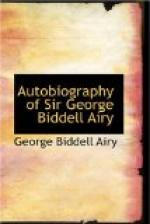“On my return to Cambridge I was immediately immersed in the work of the Observatory. The only instrument then mounted at the Observatory was the Transit. I had no Assistant whatever.—A Mr Galbraith of Edinburgh had questioned something in one of my Papers about the Figure of the Earth. I drew up a rather formal answer to it: Whewell saw my draft and drew up a much more pithy one, which I adopted and sent to the Philosophical Magazine.—For comparing our clocks at the upper and lower stations of Dolcoath we had borrowed from the Royal Observatory, Greenwich, six good pocket chronometers: they were still in the care of Mr Sheepshanks. I arranged with him that they should be sent backwards and forwards a few times for determining the longitude of Cambridge Observatory. This was done on Oct. 21st, 22nd, 23rd: the result was 23 deg.54, and this has been used to the present time (1853). It evinced an error in the Trigonometrical Survey, the origin of which was found, I think, afterwards (Dr Pearson in a letter of Dec. 17th spoke of the mistake of a may-pole for a signal-staff). I drew up a Paper on this, and gave it to the Cambridge Philosophical Society on Nov. 24th. (My only academical Paper this year.)—I had several letters from Dr Young, partly supplying me with calculations that I wanted, partly on reform or extension of the Nautical Almanac (which Dr Young resisted as much as possible). He considered me very unfairly treated in the dissolution of the Board of Longitude: Professor Lax wished me to join in some effort for its restoration, but I declined.
“As my reduction of observations was kept quite close, I now began to think of printing. In regard to the form I determined to adopt a plan totally different from that of any other observations which I had seen. The results were to be the important things: I was desirous of suppressing the separate wires of transits. But upon consulting Herschel and other persons they would not agree to it, and I assented to keeping them. I applied to the Press Syndicate to print the work, and on Nov. 10th at the request of T. Musgrave (afterwards Archbishop of York) I sent a specimen of my MS.: on Nov. 11th they granted 250 copies, and the printing soon commenced.”
1829
“During a winter holiday at Playford I wrote out some investigations about the orbits of comets, and on Jan. 23rd 1829 I returned to Cambridge. The Smith’s Prize Examination soon followed, in which I set a Paper of questions as usual. On Feb. 18th I made notes on Liesganig’s geodetic work at the British Museum.




